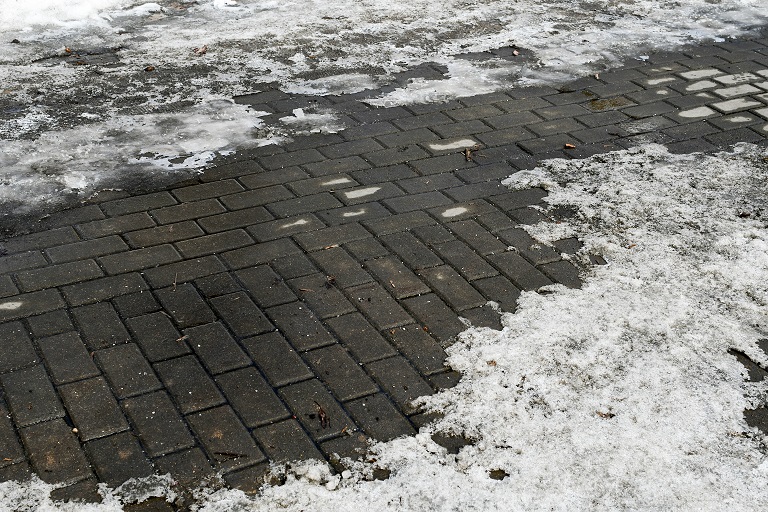
As winter fades and spring begins to bloom, many homeowners face an ugly aftermath: white, chalky streaks left behind on concrete and pavers. These unsightly marks are the result of ice melt or deicing salts — and they can leave your sidewalks, driveways, and entryways looking dirty and worn out.
So here’s the question: Can pressure washing help remove that ice melt residue? The answer is yes, but with a few important precautions.
Let’s walk through what causes this buildup, why it’s a problem, and how to safely wash it away. 🧼🧱
🧊 What Causes Ice Melt Residue?
Most deicers — like rock salt (sodium chloride), calcium chloride, or magnesium chloride — work by lowering the freezing point of water, helping to melt snow and ice faster. While effective at deicing, they come with side effects:
- ❌ Leave behind salty, white residue on surfaces
- ⚠️ Attract moisture, which can cause freeze-thaw cycles to worsen
- 🔩 Corrode metal, like railings or fasteners
- 🌱 Damage grass or nearby landscaping
Over time, this residue can become embedded into porous concrete and pavers, leading to long-term staining or surface degradation.
💧 Can Pressure Washing Help?
Yes — pressure washing is one of the most effective ways to remove salt residue from outdoor walkways and driveways. Here’s why:
- 💥 It provides the high pressure needed to dislodge crusted salt deposits
- 🚿 It penetrates porous surfaces that sweeping or hosing can’t reach
- 🧼 When combined with appropriate cleaners, it neutralizes salt and lifts it away
- 👣 Restores the original look and improves surface safety
However, for best results, it’s important to use the right method and detergent — plain water alone might not fully neutralize the salts.
Browse Amazon Here For Popular Pressure Washers And Accessories
⚠️ Why Not Just Hose It Down?
While hosing can help rinse away loose particles, it doesn’t provide the force or depth to remove buildup deep within the surface pores of concrete or brick. Also, using just water doesn’t neutralize the chloride compounds, which may continue to attract moisture and cause corrosion or scaling over time.
Pressure washing is a deeper clean — think of it as detoxing your walkways. 💪
🧴 What Type of Cleaner Should I Use?
For best results, use a cleaner specifically formulated to:
- ✅ Neutralize salts (sometimes called salt removers or efflorescence removers)
- ✅ Clean and brighten masonry surfaces
- ✅ Break down mineral-based stains
Many professional-grade solutions are acid-based, such as:
- Muriatic acid (use with extreme caution)
- Citric acid (safer and more eco-friendly)
- Sulfamic acid (effective on concrete and stone)
💡 Tip: Always spot test first, and wear protective gear when using acidic cleaners.
🚿 Step-by-Step: Removing Ice Melt with a Pressure Washer
- Sweep Away Loose Salt
Use a broom or blower to remove as much debris and dry salt as possible. - Pre-wet the Area
Lightly wet the surface to prevent rapid absorption of the cleaner into the pores. - Apply Salt-Removing Cleaner
Use a sprayer or the detergent tank on your pressure washer. Let it dwell for 5–10 minutes (check label instructions). - Pressure Wash Thoroughly
Use a 25- to 40-degree nozzle for even coverage. Keep the wand moving and maintain 8–12 inches distance. - Rinse Well
Follow up with a thorough clean water rinse to remove all detergent and dislodged salt.
🌱 Is It Environmentally Safe?
Salt runoff can harm grass, plants, and water systems. Look for eco-friendly, biodegradable cleaners and avoid directing runoff into storm drains. If you’re near a garden bed or pond, cover or divert water flow accordingly.
🧠 Bonus Tips
- 🗓️ Clean early in spring before foot traffic and sun bake the residue in further
- 🔧 After cleaning, inspect for cracks or flaking caused by salt damage
- 🧴 Consider sealing your concrete to protect against future salt intrusion
- ❌ Avoid using pressure above 3,000 PSI on delicate masonry — it can cause etching
🧽 Final Thoughts
Pressure washing is one of the most effective ways to remove stubborn ice melt residue and restore your walkway’s appearance. With the right cleaner, nozzle, and technique, you’ll lift away stains and give your surfaces a much-needed refresh after a long winter. ❄️🧱🚿
Don’t let that salty crust linger — bring your concrete back to life and get ready for spring the clean way! 🌷✨
Browse Amazon Here For Popular Pressure Washers And Accessories






